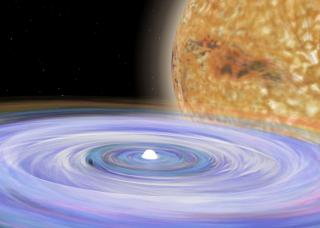Bibcode
Dobrotka, A.; Mineshige, S.; Casares, J.
Bibliographical reference
Monthly Notices of the Royal Astronomical Society, Volume 420, Issue 3, pp. 2467-2474.
Advertised on:
3
2012
Citations
12
Refereed citations
11
Description
We present a study of the flickering activity in two nova-like systems,
KR Aur and UU Aqr. We applied a statistical model of flickering
simulations in accretion discs based on turbulent angular momentum
transport between two adjacent rings with an exponential distribution of
the turbulence dimension scale. The model is based on a steady-state
disc model, which is satisfied in the case of hot ionized discs of
nova-like cataclysmic variables. Our model successfully fits the
observed power-density spectrum of KR Aur with the disc parameter
α= 0.10-0.40 and an inner-disc truncation radius in the range
Rin= 0.88-1.67 × 109 cm. The exact values
depend on the mass-transfer rate in the sense that α decreases and
Rin increases with mass-transfer rate. In any case, the
inner-disc radius found for KR Aur is considerably smaller than those
for quiescent dwarf novae, as predicted by the disc instability model.
On the other hand, our simulations fail to reproduce the power-density
spectrum of UU Aqr. A tantalizing explanation involves the possible
presence of spiral waves, which are expected in UU Aqr because of its
low mass ratio but not in KR Aur. In general our model predicts the
observed concentration of flickering in the central disc. We explain
this by the radial dependence of the angular-momentum gradient.
Related projects

Binary Stars
The study of binary stars is essential to stellar astrophysics. A large number of stars form and evolve within binary systems. Therefore, their study is fundamental to understand stellar and galactic evolution. Particularly relevant is that binary systems are still the best source of precise stellar mass and radius measurements. Research lines
Pablo
Rodríguez Gil